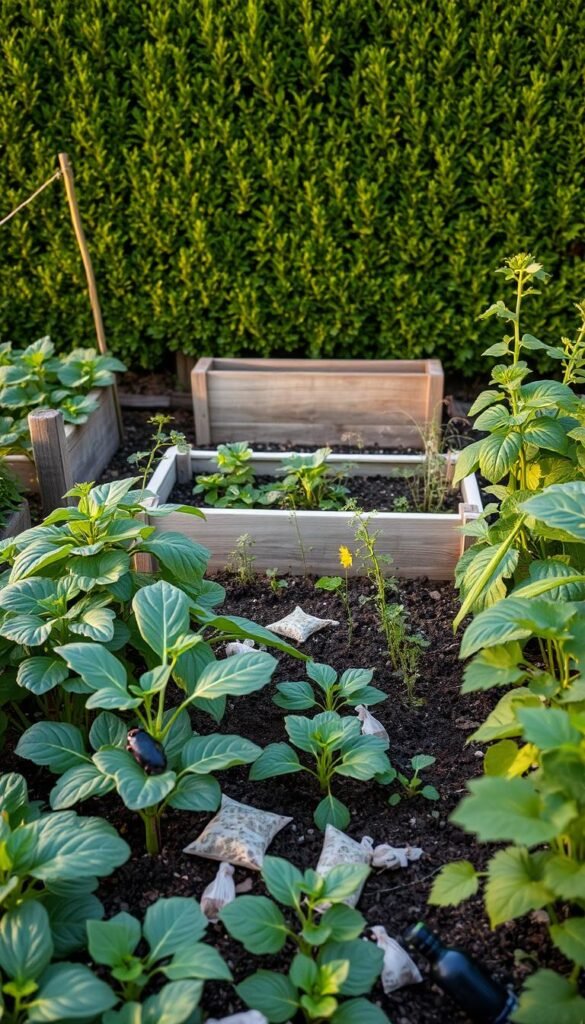Growing vibrant flowers or fresh veggies in limited spaces brings joy—until unwanted visitors arrive. Dealing with critters doesn’t require harsh chemicals. With thoughtful planning, you can create a balanced ecosystem that keeps plants thriving and pests at bay.
Healthy soil is your first line of defense. Enriching dirt with compost boosts plant immunity, making them less tempting to invaders. Pair this with natural solutions like companion planting—think basil shielding tomatoes—or homemade garlic spray to deter bugs without harming beneficial insects.
Many gardeners swear by these methods. For example, marigolds repel nematodes, while nasturtiums lure aphids away from prized greens. If you’re managing a balcony setup, explore eco-friendly pest control solutions tailored for tighter spaces.
This guide will show you how to spot early signs of trouble, like chewed leaves or sticky residue. You’ll learn preventive steps, from attracting ladybugs to adjusting watering habits. Together, we’ll build habits that keep your green space lush, safe, and productive—all while working with nature, not against it.
Understanding the Pest Challenges in Your Compact Garden
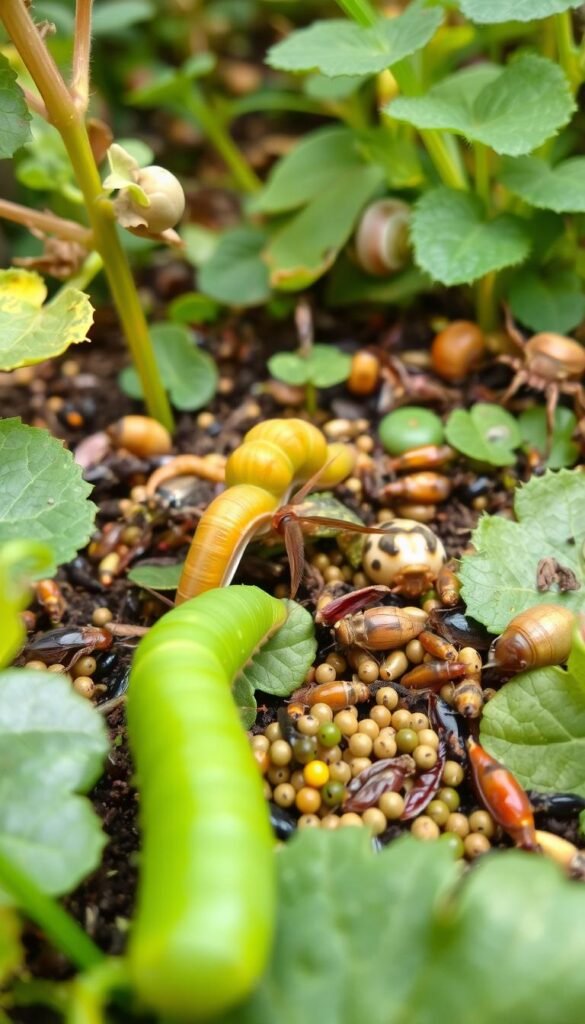
Tiny gardens burst with life, but hidden threats can quickly turn lush greens into struggling patches. Whether you’re nurturing herbs on a windowsill or veggies in raised beds, knowing your enemy is half the battle won.
Spotting Trouble Before It Spreads
Common garden pests like aphids, beetles, and caterpillars target tender leaves first. These bugs drain plant sap, leaving behind yellow speckles or curled edges. Slugs and snails often chew irregular holes overnight, while spider mites create fine webs under foliage.
Organic gardening focuses on prevention through observation. Check plants weekly for these clues:
- Translucent trails on leaves (slug activity)
- Clusters of tiny green or black insects (aphid colonies)
- Sudden wilting despite proper watering (root nematodes)
Decoding Plant Distress Signals
Discolored patches or sticky residue often signal larger issues. Beetles skeletonize leaves, leaving only veins intact. Whiteflies cause a powdery film, while thrips scrape surfaces until plants look silvery.
Early detection lets you act before pests garden-wide. Compare damage patterns—chewed edges versus random holes—to identify culprits. Healthy soil and strategic planting reduce vulnerabilities, but consistent monitoring remains key. Remember: stressed plants attract more bugs, so address issues promptly to break the cycle.
DIY Pest Control for Compact Garden Plots: Getting Started
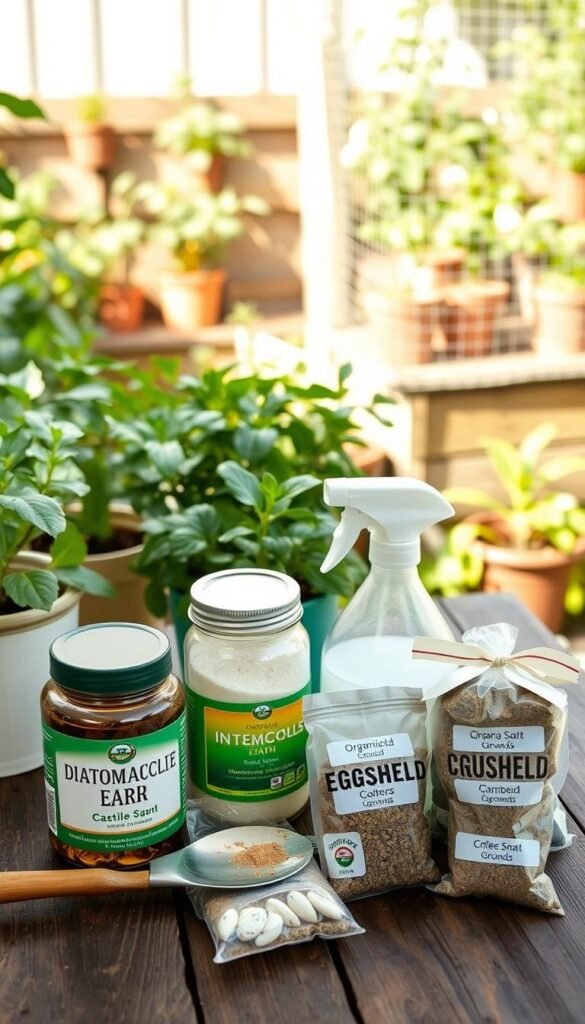
Starting with simple, safe solutions keeps your plants healthy and vibrant. Organic methods work with your garden’s ecosystem, avoiding harm to pollinators like bees. This approach builds resilience over time while protecting your harvest.
Why Chemical-Free Works Better
Natural sprays and barriers prevent pests without disrupting soil balance. Unlike synthetic options, they don’t leave toxic residues. You’ll also save money—most recipes use items like dish soap or garlic.
Here’s how organic and chemical options compare:
| Method | Safety | Cost | Effectiveness |
|---|---|---|---|
| Homemade sprays | Safe for pets | $2–$5 | 3–5 days |
| Store-bought chemicals | Harmful if inhaled | $15+ | Immediate |
| Companion plants | 100% natural | $3–$10 | Ongoing |
Gathering Your Toolkit
You’ll need a spray bottle, clean water, and mild soap. Neem oil or peppermint essential oils boost effectiveness against aphids. Always test mixes on a small plant part first.
Safety matters: Wear gloves when handling sprays. Store mixtures away from kids. Apply early morning or evening—direct sun can burn treated leaves. With a little time each week, you’ll master these steps and enjoy a thriving green space.
Creating an Effective Organic Garden Spray
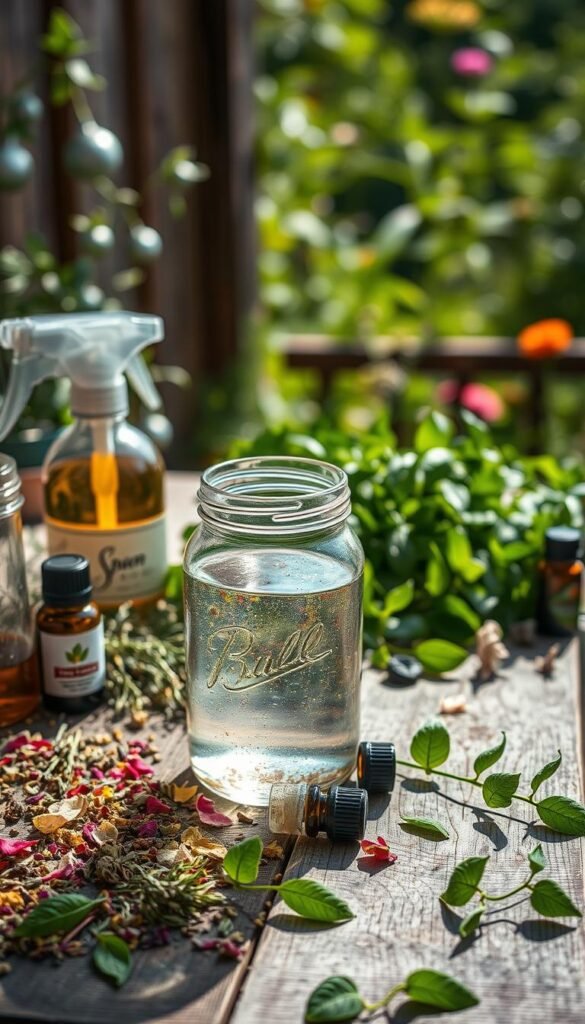
Crafting your own plant-safe formulas turns everyday ingredients into powerful pest solutions. These mixtures protect leaves while preserving soil health—and they’re simple to whip up in minutes.
Essential Oil Blend Recipe
Start with this 3-ingredient powerhouse: Combine 1 quart of water, 1 teaspoon of liquid castile soap, and 15 drops of peppermint oil. The soap breaks down pests’ protective coatings, while peppermint disrupts their feeding habits. Shake vigorously before each use—oils separate quickly.
Apply at dawn or dusk to avoid sun-scorched leaves. Focus on leaf undersides where bugs hide. Reapply every 3 days during infestations, or after rainfall washes off the protective layer.
Balancing Soap and Water
Too much soap can harm plants, while too little reduces sticking power. Stick to a 1:500 ratio—1 teaspoon soap per quart of water. Castile soap works best because it’s plant-based and residue-free.
| Spray Type | Safety | Cost Per Batch | Active Duration |
|---|---|---|---|
| Homemade Mix | Non-toxic | $0.25 | 3–5 days |
| Store-Bought | Skin irritant | $4.50 | 7–10 days |
Seasoned growers recommend adding a splash of neem oil for stubborn beetles. Always label containers clearly and store mixes in cool, dark places. Your plants get protection without synthetic chemicals—and you save money for more seeds!
Enhancing Pest Resistance with Companion Planting and Beneficial Insects
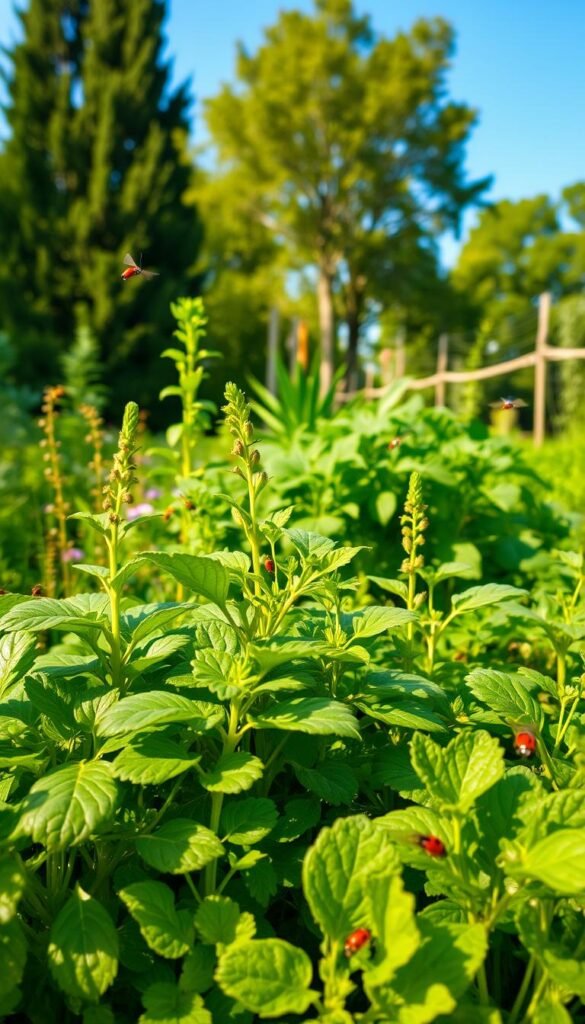
Your garden’s secret weapon might already be growing in your herb planter. Strategic pairings between herbs and vegetables create invisible shields against invaders while welcoming nature’s pest patrols.
Nature’s Matchmaking Magic
Basil isn’t just for pasta sauce—plant it near tomatoes to repel hornworms. Dill protects cabbage from moth larvae, while chives keep aphids off roses. These partnerships work because strong scents confuse pests hunting for their favorite snacks.
Top plant pairings every gardener should try:
- Carrots + rosemary (deters carrot flies)
- Cucumbers + nasturtiums (traps beetles)
- Peppers + oregano (blocks spider mites)
Recruiting Six-Legged Allies
Lady beetles devour 50+ aphids daily. Lacewings feast on mealybugs, while hoverflies target thrips. To attract these helpers:
| Insect | Favorite Plants | Pests Controlled |
|---|---|---|
| Lady beetles | Dill, yarrow | Aphids, mites |
| Lacewings | Cosmos, goldenrod | Whiteflies, scales |
| Hoverflies | Marigolds, alyssum | Thrips, caterpillars |
Leave some bare soil for ground beetles—they hunt slugs at night. Avoid broad-spectrum sprays, which harm both pests and pollinators. A diverse planting scheme creates year-round habitats, turning your plot into a bug hotel that works for you.
Experiment with different combinations each season. Track which pairings reduce damage to your vegetable crops. Remember—balance is key. Too many strong-smelling herbs might deter helpful beneficial insects along with the bad ones!
Integrated Pest Management Strategies for Your Garden

Smart gardening combines prevention and observation to create lasting protection. This holistic approach reduces plant stress while keeping your green space thriving. Let’s explore how simple adjustments can stop problems before they start.
Barriers That Work Smarter
Physical blocks offer reliable defense against hungry critters. Row covers shield seedlings from beetles, while copper tape repels slugs. For transplants, cardboard collars prevent cutworms from chewing stems.
| Barrier Type | Best For | Installation Tips |
|---|---|---|
| Floating row covers | Leaf-eating insects | Secure edges with soil |
| Chicken wire cages | Animal visitors | Bury 6″ deep |
| Sticky traps | Flying pests | Hang near blooms |
Timing matters too. Plant squash after vine borers’ active period ends. Schedule bean plantings to avoid peak beetle seasons. These strategic delays minimize exposure to destructive insects.
Catch Problems Early
Weekly checks help spot issues before they escalate. Look for chewed leaves or wilting stems. Identify these common visitors:
- Helpful: Ladybugs (rounded bodies), lacewings (delicate wings)
- Harmful: Japanese beetles (shiny shells), cabbage worms (green stripes)
When action’s needed, try garlic spray or diatomaceous earth. These natural pesticide alternatives target specific pests without harming bees. Remember—consistent care creates a balanced ecosystem where plants defend themselves naturally.
Boosting Soil and Plant Health Organically
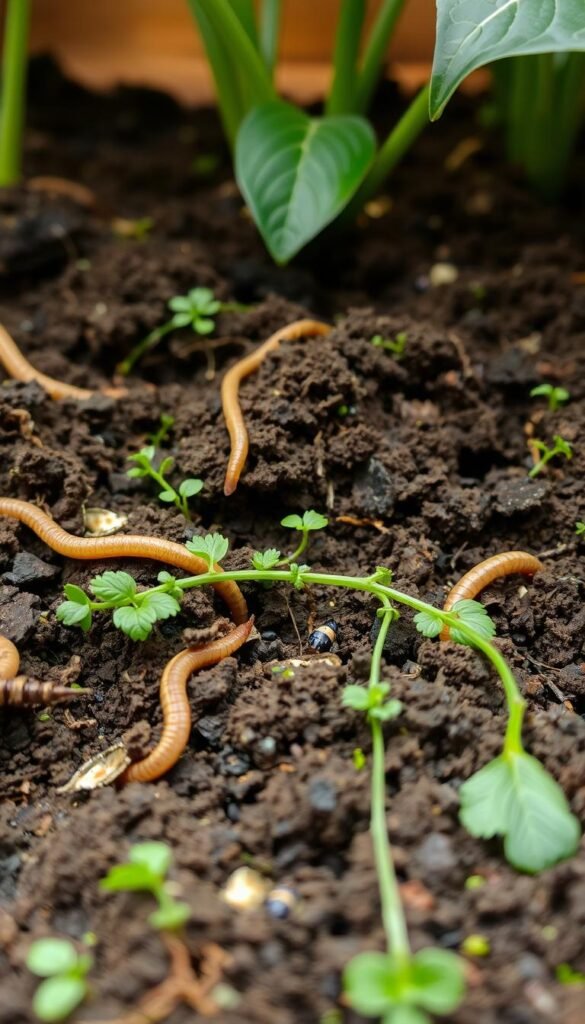
Rich soil teems with life, quietly building your garden’s resilience from the ground up. Healthy dirt feeds roots, strengthens stems, and helps plants naturally resist invaders. Think of it as your garden’s immune system—when soil thrives, pests struggle to gain a foothold.
Start with compost—nature’s multivitamin. Mixing aged compost into beds adds nutrients and improves drainage. This creates a welcoming home for earthworms and microbes that break down organic matter into plant-ready food. Even in small-space setups like balcony gardens, compost tea works wonders for container-grown greens.
Natural amendments do more than feed plants. Crushed eggshells add calcium to prevent blossom rot. Coffee grounds boost nitrogen levels for leafy growth. Garlic isn’t just for pest sprays—chopped cloves buried near roses deter beetles while enriching the earth.
| Amendment | Benefit | Best For |
|---|---|---|
| Compost | Balanced nutrients | All plants |
| Worm castings | Microbe boost | Seedlings |
| Bone meal | Phosphorus source | Flowering plants |
Healthy gardens start with mindful soil care. Test your dirt yearly to spot deficiencies. Add organic mulch to retain moisture and suppress weeds. Over time, these habits create an ecosystem where plants grow sturdy—less appealing to bugs hunting weak targets.
Your efforts pay off in vibrant blooms and bountiful harvests. By prioritizing soil health today, you’ll spend less time battling pests tomorrow. Nature handles the heavy lifting when you give it the right tools.
Final Thoughts on Achieving a Thriving, Pest-Free Garden
A thriving garden balances vigilance with nature’s harmony. By embracing natural solutions, you protect plants without harsh chemicals that disrupt soil health. Integrated strategies—companion planting, homemade sprays, and attracting beneficial guys like ladybugs—create layered defenses against insect pests.
Daily observation is key. Spotting bug activity early lets you act before infestations grow. Simple ways to adjust—like rotating crops or timing plantings—make any day a chance to outsmart invaders.
Avoiding synthetic products preserves pollinators and soil microbes. Experiment with different methods: garlic spray deters aphids, while marigolds block nematodes. What works today might need tweaking tomorrow—stay flexible!
Your efforts build a resilient ecosystem where plants thrive naturally. With patience and eco-smart habits, you’ll grow more than veggies—you’ll cultivate lasting garden joy.

